Wyoming, also called the Equality State, is located in the western part of the United States, more precisely in the Mountain West subregion. Even though it’s the 10th largest state in the U.S., Wyoming is known as the one with the second-lowest population density.
The state exhibits interesting geography, especially from a flora and fauna point of view. Wyoming’s eastern half is covered by High Plains (high-elevation prairie), and its western half by various formations of the Rocky Mountains.
In terms of climate, the state is windy and dry and characterized as continental and semi-arid. The highest temperature recorded in Wyoming was 114 °F (almost 47 °C) – due to its climate, the state is known for having extreme temperatures.
Wyoming is known for its mountain ranges, basins, and even a couple of islands (32, to be exact). As such, it can be said that it has all the right ingredients for a haven of flora and fauna. In the following lines, you’ll learn more about the flora – some of Wyoming’s native plants.
What Is a Native Plant?
A plant can be called native when it spent a couple of thousands of years in the same region. The presence of a certain plant within the territory of Wyoming earns it the title of indigenous or native.
Such plants have adapted and are constantly adapting to the region’s climate, soil conditions, weather, light, etc. They are part of their ecosystems, where they occur naturally!
8 Native Plants in Wyoming
1. Columbian Monkshood
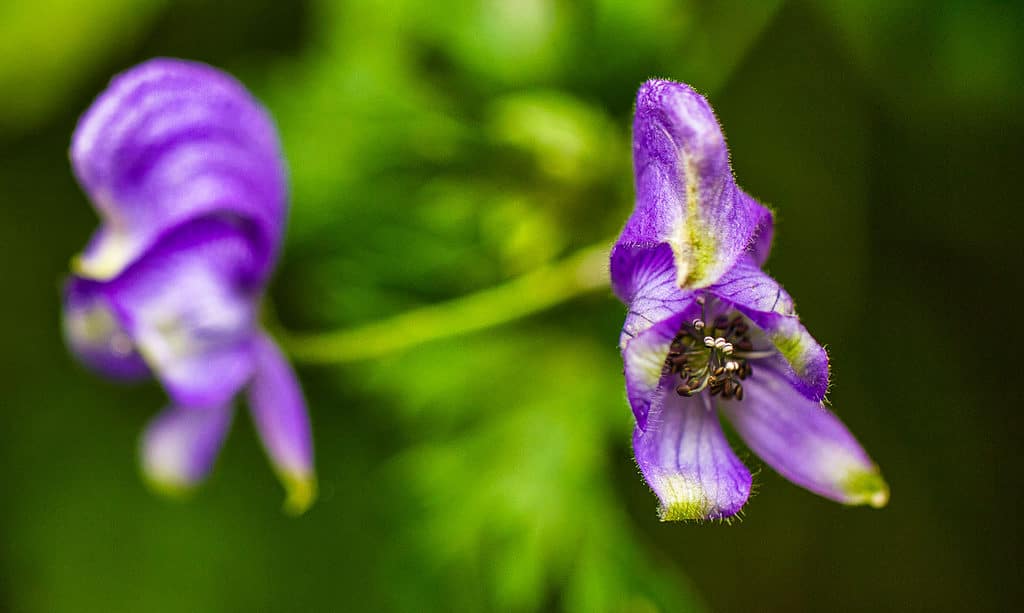
The Columbian monkshood grows in moist areas, especially in riparian areas, coniferous forests, and meadows.
©Paulina Wietrzy-Pelka/Shutterstock.com
| Columbian Monkshood | |
|---|---|
| Scientific name | Aconitum columbianum |
| Type of plant | Perennial |
| Distribution | Western North America |
Called western monkshood or Columbian monkshood, Aconitum columbianum is part of the Ranunculaceae (buttercup) family of plants. It can be found throughout western North America – all western states of the U.S. and a part of western Canada (except much of the coastline).
The Columbian monkshood grows in moist areas, especially in riparian areas, coniferous forests, and meadows. It likes high altitudes, as you can find it only at altitudes above 2,000 feet (600 m). If you’re trekking to the high mountain peaks, you can also find it there – up to 9,500 feet (2,900 m) high.
The plant stands out from the crowd thanks to its wrinkly flowers. They are folded, but this doesn’t hide their vivid colors – ranging from purple to deep blue, yellowish, and white. Don’t get too close, as the plant is poisonous to livestock and humans!
2. Showy Milkweed
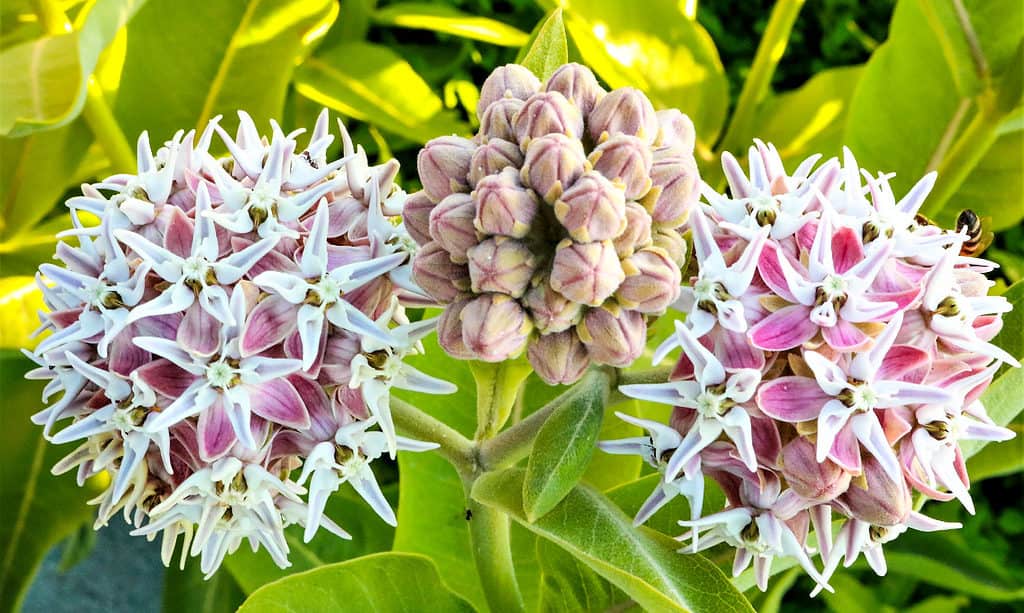
The showy milkweed can reach heights of up to 47 inches.
©Pinky Purple/Shutterstock.com
| Showy Milkweed | |
|---|---|
| Scientific name | Asclepias speciosa |
| Type of plant | Perennial |
| Distribution | Western North America |
The showy milkweed is part of the dogbane family, which includes mainly vines, succulents, herbs, some trees, and shrubs. You can find this plant throughout the western half of North America, usually in open woodland areas, roadsides, dry slopes, and streams. It is not a picky species.
The showy milkweed can reach heights of up to 47 inches (120 cm) and features pointed, long leaves (roughly 4-8 inches (10-20 cm) long). As its name implies, the showy milkweed releases milky sap when its stems or leaves are cut or bruised.
Its striking feature is the flower, as it resembles a prickly star. Showy milkweed flowers gather in umbellate cymes that can get quite dense. They grow to roughly 0.75 inches (2 cm) wide and are usually pink (may have shades of purple too).
3. Nodding Onion
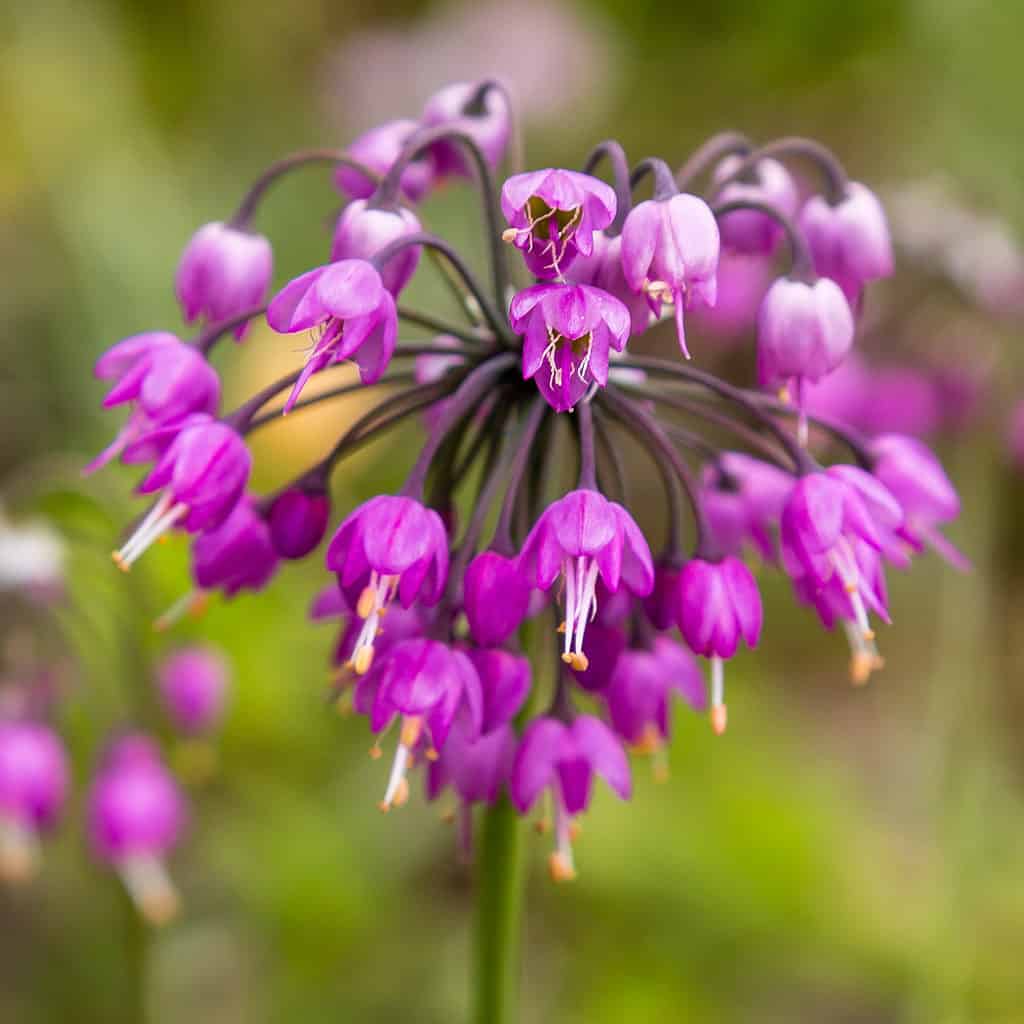
The nodding onion can be found throughout North America, especially in open areas.
©Flower_Garden/Shutterstock.com
| Nodding Onion | |
|---|---|
| Scientific name | Allium cernuum |
| Type of plant | Perennial |
| Distribution | Throughout North America |
Also known as the lady’s leek, the nodding onion is a plant found throughout North America, especially in open areas. The plant’s striking feature consists of its inflorescence pointing down. You don’t have to visit Wyoming to increase your chances of seeing this species, but discovering this state does help.
The nodding onion can be easily mistaken for wild leeks and wild garlic plants, and this is partly due to the aspect of its flowering stem. Each nodding onion specimen bears a single stem that features one umbel that nods downward (hence the name). The umbel can feature either rose or white flowers.
Upon reaching maturity, the flowers reveal the plant’s spherical and crested fruits. Ultimately, the flower head will turn into a seed head, as the crested fruits will split, unraveling some dark shiny seeds.
4. Bitter Dogbane
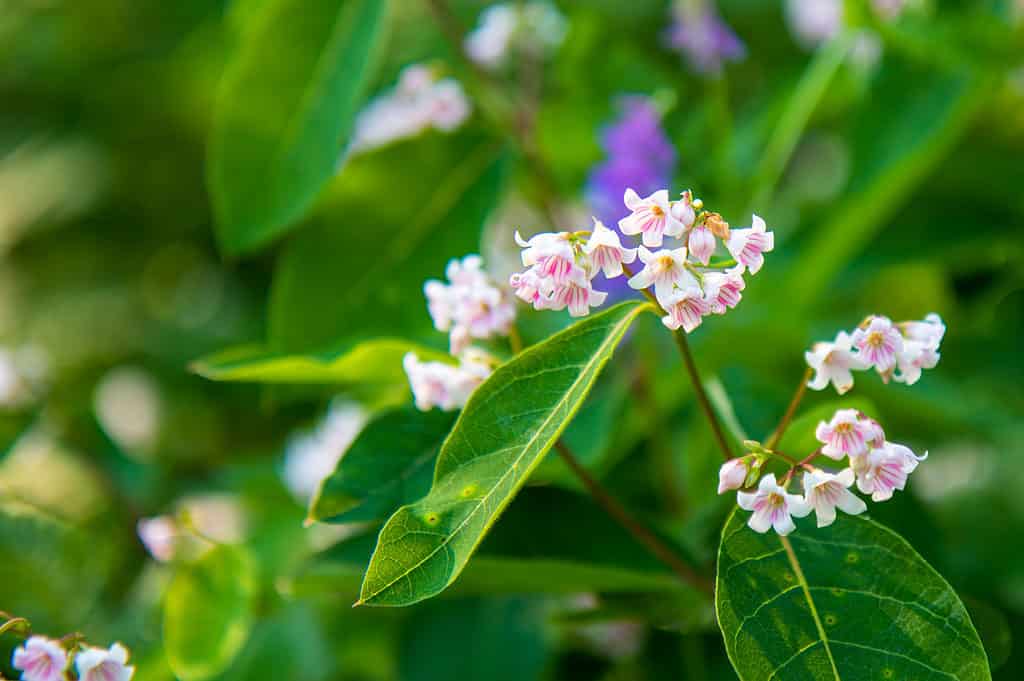
The bitter dogbane usually grows up to 8-12 inches tall.
©Ashley Swanson/Shutterstock.com
| Bitter Dogbane | |
|---|---|
| Scientific name | Apocynum androsaemifolium |
| Type of plant | Perennial |
| Distribution | North America |
A common plant in North America, the bitter dogbane is often called spreading or fly-trap dogbane. It is part of the Apocynaceae family, which consists mainly of trees, herbs, shrubs, vines, and some stem succulents. There are roughly seven varieties and subspecies of Apocynum androsaemifolium. Out of them, subsp. pumilum and var. woodsonii are specifically native to Wyoming, although you may occasionally stumble upon other varieties as well.
The bitter dogbane usually grows up to 8-12 inches (20-30 cm) tall. In some rare cases, it can get as tall as 20 inches (50 cm), but this is generally a small-sized plant. It is characterized by hairy leaf undersides and by the fact that it releases milky sap when its stems get broken.
You can see the plant bloom between June and September. This is when pink flowers appear in pairs on bitter dogbane stems. Each flower features its own seed pod, which is, in turn, equipped with haired seeds ready to propagate Apocynum androsaemifolium.
5. Rock Jasmine
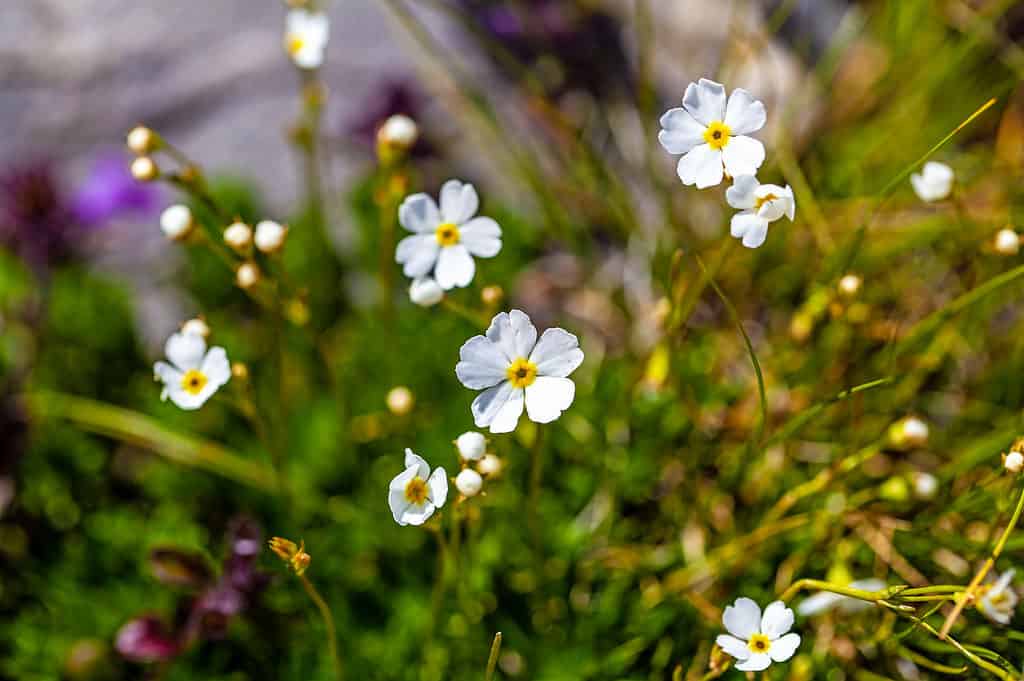
The rock jasmine is a ground-level plant with many stems holding small umbels.
©ChWeiss/Shutterstock.com
| Rock Jasmine | |
|---|---|
| Scientific name | Androsace septentrionalis |
| Type of plant | Annual |
| Distribution | North America, Europe, Asia |
The rock jasmine goes by many names – northern rockjasmine, pygmy-flower rock-jasmine, and Northern fairy candelabra, to name a few (in Chinese, it is known as bei dian di mei). The plant is native to North America, Europe, and Asia, and it is part of the Primulaceae family (primrose family, which includes wildflowers and garden plants).
Unlike many species of the primrose family, the rock jasmine can’t be described as strikingly beautiful. It features rather small flowers and can be easily missed if you’re not paying attention.
The rock jasmine is a ground-level plant with many stems holding small umbels. Its rosette bears simple, small, toothed leaves. There are, however, certain varieties that feature bigger, pure white flowers.
6. Elegant Death Camas
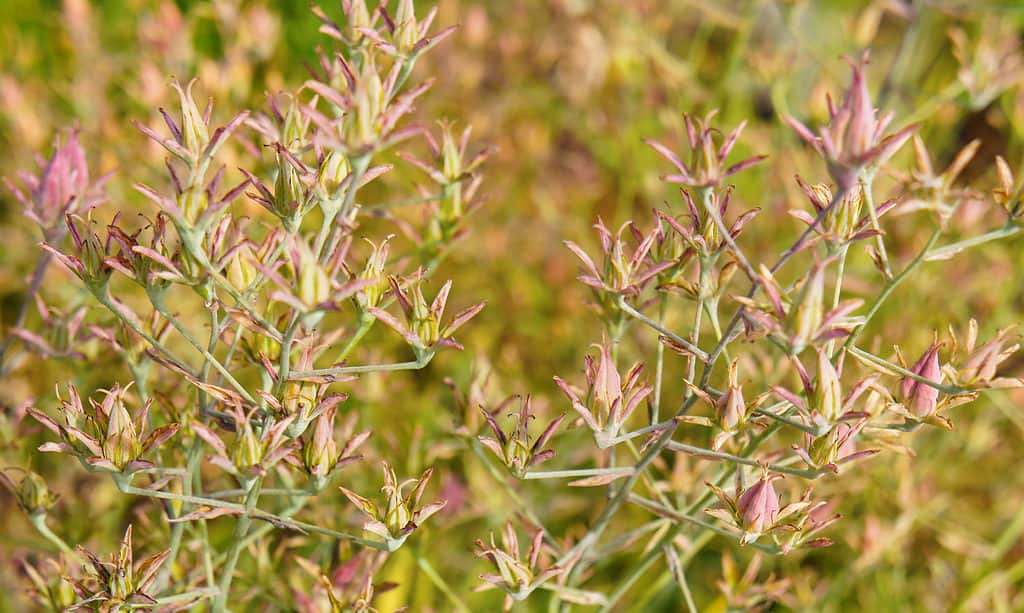
All parts of the elegant death camas are poisonous and will cause severe effects if ingested.
©iStock.com/skymoon13
| Elegant Death Camas | |
|---|---|
| Scientific name | Anticlea elegans |
| Type of plant | Perennial |
| Distribution | Throughout North America |
Suppose you ever come across a nodding onion (or a similar plant like garlic) that lacks the specific onion-ish smell. In that case, you might be face to face with a death camas species. The fact that matters is that death camas are poisonous. These plants are part of the Melanthiaceae family, also known as bunchflower.
Anticlea elegans, commonly known as mountain death camas, elegant camas, or alkali grass, is spread throughout North America. It can be recognized by its lily-like flowers that, unlike actual lilies, feature two-pronged glands on every single petal. This characteristic is unique to this particular species.
All parts of the plant are poisonous and will cause severe effects if ingested – vomiting, nausea, headache, and salivation, to name a few.
7. Red Windflower
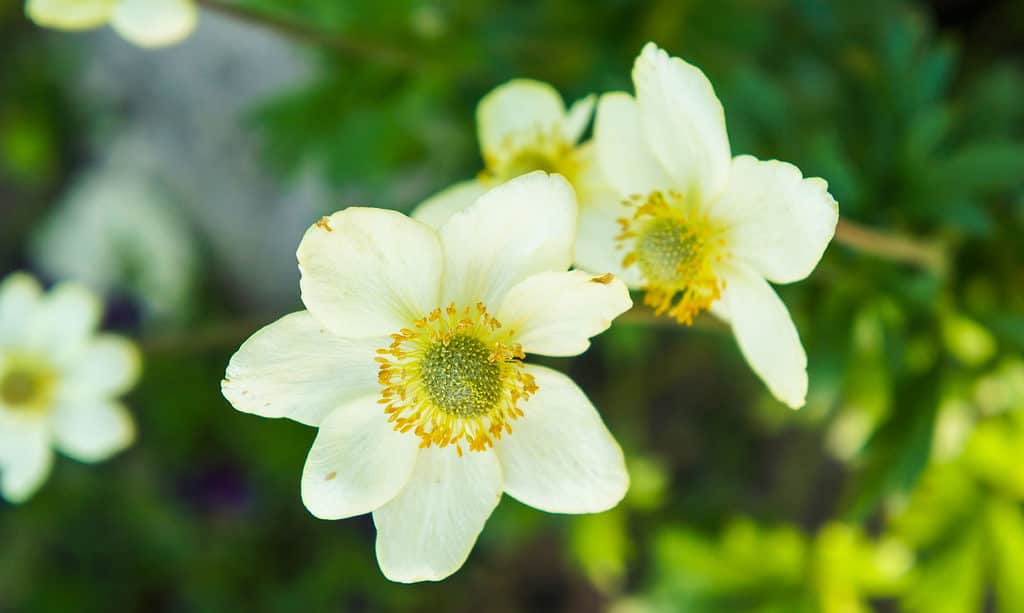
The red windflower usually grows up to 3.9-27.5 inches tall.
©iStock.com/skymoon13
| Red Windflower | |
|---|---|
| Scientific name | Anemone multifida |
| Type of plant | Perennial |
| Distribution | Northern North America, parts of South America |
The red windflower is rarely called a red windflower, ironically. Instead, you’ll find people often referring to it as cutleaf anemone, globe anemone, or Pacific anemone. It is part of the buttercup family Ranunculaceae and can be found throughout northern North America and parts of South America.
The plant is rarely called red windflower due to the differences across varieties (differences stemming from the diverse habitats it is found in). It usually grows up to 3.9-27.5 inches (10-70 cm) tall. Its leaves are covered in white hairs, and feature pointed subdivided lobes.
The red windflower comes equipped with a complex flower head. The plant’s flowers have no petals; instead, they feature sepals of any color in the spectrum. In most cases, these are white, but the name of the red windflower must have a definite origin, right?
8. Prairie Onion
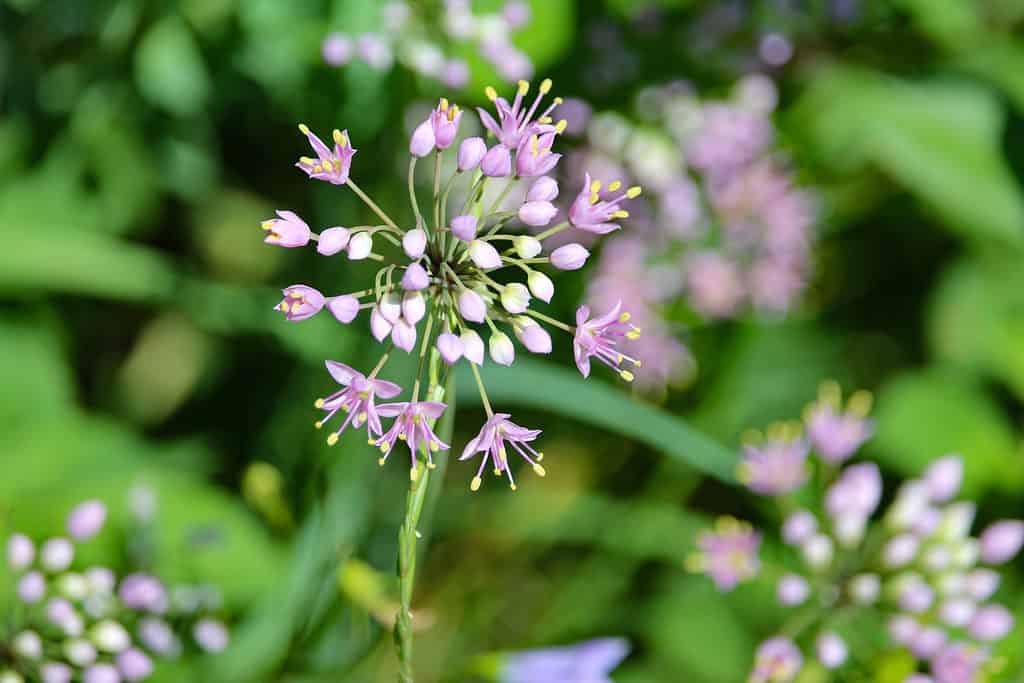
The prairie onion usually grows up to 1-2 feet tall.
©iStock.com/Jerrold James Griffith
| Prairie Onion | |
|---|---|
| Scientific name | Allium stellatum |
| Type of plant | Perennial |
| Distribution | Central United States, central Canada |
Often referred to as cliff onion, glade onion, and autumn onion, the prairie onion is – you guessed it! – a species of wild onion commonly found throughout the central part of the United States and in central Canada. Like other onions, the prairie onion features flowers that grow on rounded umbels.
The plant usually grows up to 1-2 feet (30-60 cm) tall and originates in basal leaves that closely resemble grass. As the prairie onion reaches maturity, its basal leaves die to make room for the rounded umbel (flower head). The umbel features pink to purple flowers and is about 2-3 inches (5-8 cm) wide.
While the bulbs reportedly have a strong flavor, this indicates that you’re not dealing with a death camas species and that said bulbs are edible.
Up Next:
- Discover the Highest Point in Wyoming
- Discover the 7 best National Parks in Wyoming
- The 5 Best Places to Camp in Wyoming this Summer
The photo featured at the top of this post is © Ashley Swanson/Shutterstock.com
Thank you for reading! Have some feedback for us? Contact the AZ Animals editorial team.






